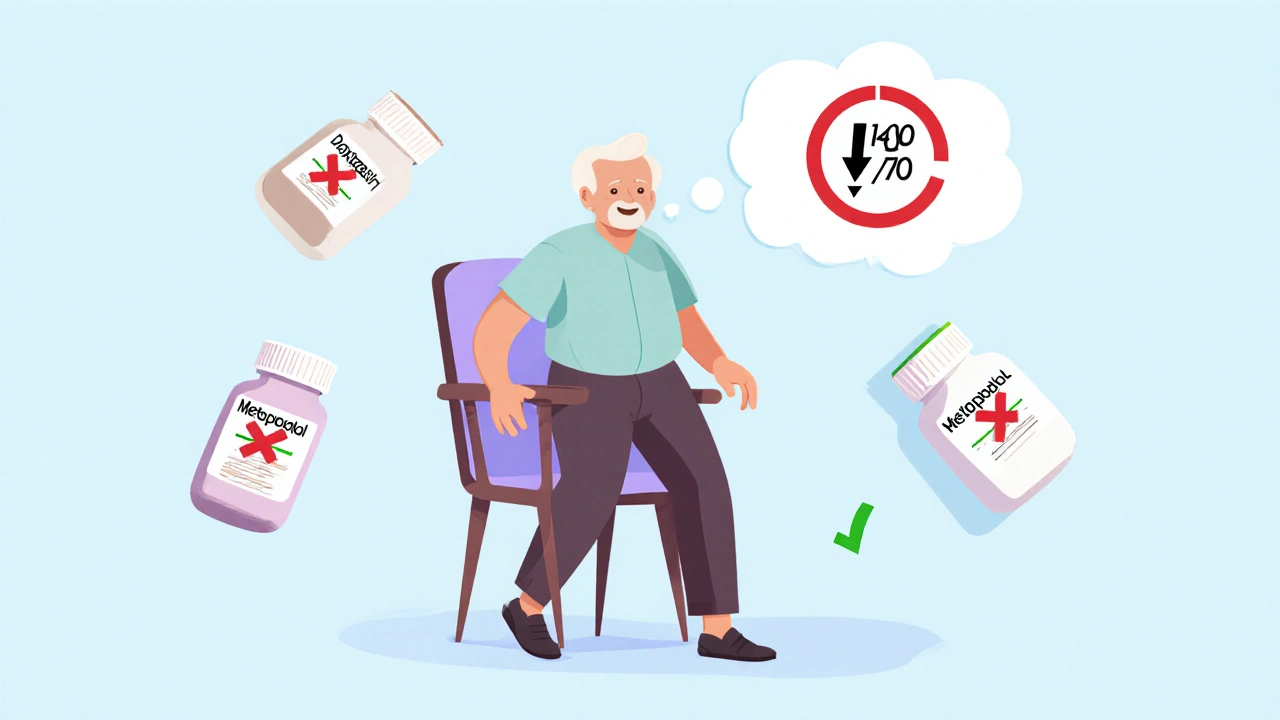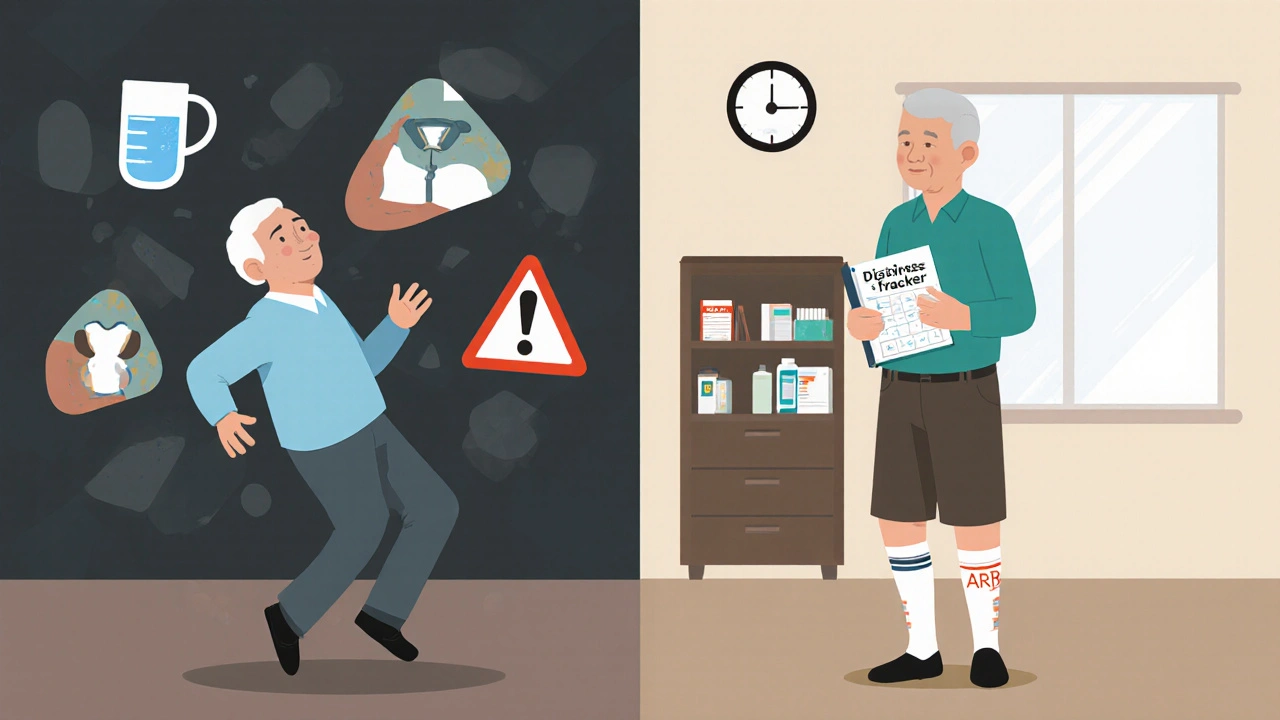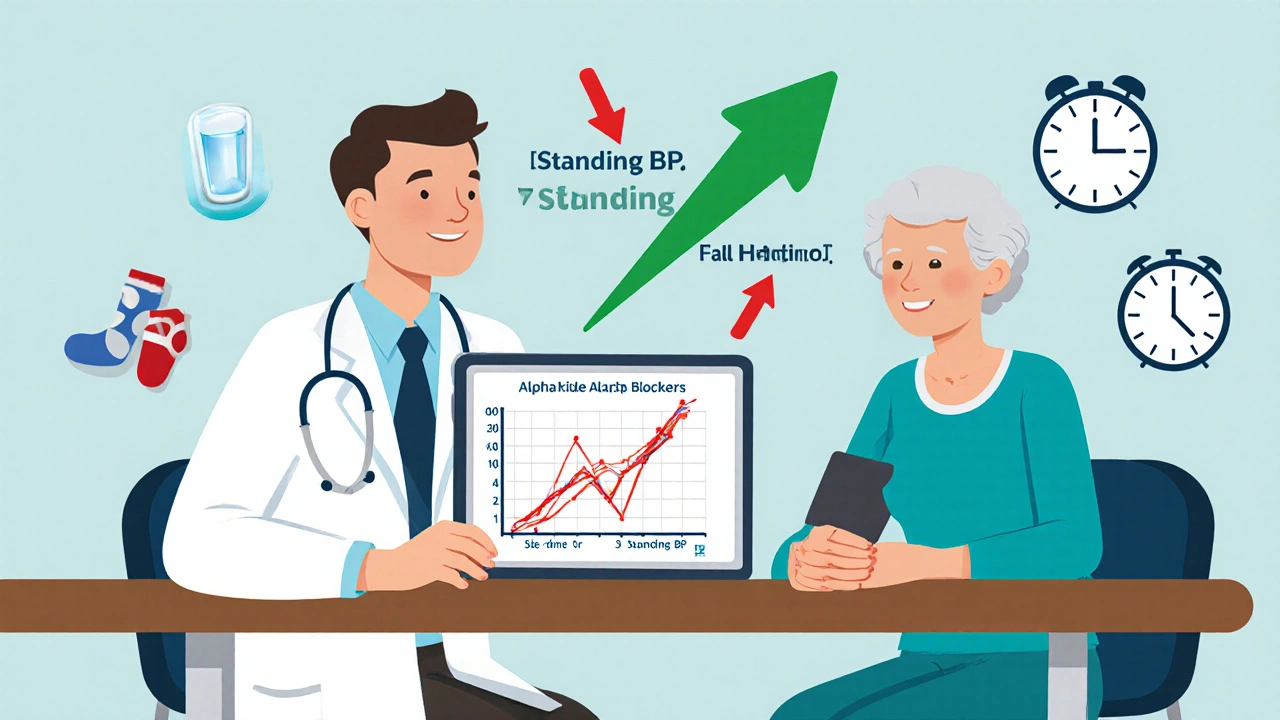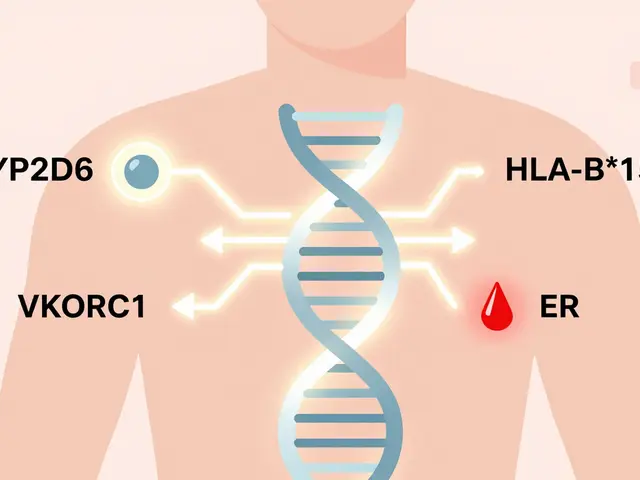
Standing up from a chair and feeling dizzy? That’s not just aging-it could be orthostatic hypotension, a dangerous side effect of blood pressure meds in older adults. About 1 in 5 seniors on antihypertensives experience this sudden drop in blood pressure when they stand, leading to falls, fractures, and hospital visits. The scary part? Many doctors still think lowering blood pressure too much causes this. But the latest science says the opposite: aggressive treatment might actually protect you.
What Exactly Is Orthostatic Hypotension?
Orthostatic hypotension isn’t just a quick dizzy spell. It’s a measurable drop in blood pressure-20 mm Hg in systolic or 10 mm Hg in diastolic-within three minutes of standing. This happens because your body can’t adjust fast enough to keep blood flowing to your brain. In younger people, baroreceptors (your body’s pressure sensors) kick in instantly. In older adults, those sensors wear out. Add in medications, and the risk spikes.It’s not rare. Studies show 3% to 26% of hypertensive seniors have it. That’s up to 19 million people in the U.S. alone. And it’s not just about dizziness. Falls tied to this condition lead to over 200,000 hip fractures yearly in the U.S. among seniors. Yet, many still treat it by cutting meds-wrong move.
Which Blood Pressure Drugs Are Riskiest?
Not all antihypertensives are equal when it comes to orthostatic risk. Some are far more likely to cause trouble than others.- Alpha blockers (like doxazosin, terazosin): Highest risk. Up to 28% of seniors on these develop orthostatic hypotension. They relax blood vessels too aggressively, especially when standing.
- Beta-blockers (like metoprolol, atenolol): Double the risk. Odds of sustained low BP when standing jump 3.36 times. They slow heart rate and reduce cardiac output-exactly what you don’t want when standing up.
- Diuretics (like furosemide, hydrochlorothiazide): Cause dehydration and volume loss. Easy to overlook, but a major contributor.
- Central sympatholytics (like clonidine): Reduce nerve signals that maintain BP. High risk, especially in frail seniors.
- Calcium channel blockers: Mixed bag. Amlodipine and lacidipine are fine long-term. But diltiazem and verapamil? Riskier due to slower liver metabolism in older adults.
- ACE inhibitors and ARBs (like lisinopril, losartan): Safest choice. Studies show 14-15% lower incidence of orthostatic hypotension compared to other classes. Some even suggest they help prevent it.
Here’s what you need to know: If you’re on an alpha blocker or a beta-blocker and feel lightheaded when standing, it’s not normal. It’s a red flag. And switching to an ARB or ACE inhibitor isn’t just safer-it’s often more effective for long-term heart health.
Why More Aggressive BP Control Might Be Safer
The old thinking was simple: lower BP = more dizziness. But the SPRINT trial and nine other major studies shattered that myth. When researchers compared seniors with systolic BP targets under 120 mm Hg versus under 140 mm Hg, the more intensive group had no increase in orthostatic hypotension. In fact, they had a 17% lower risk.Why? Because tight control reduces arterial stiffness and improves vascular responsiveness. It’s not the low number that causes the problem-it’s the instability. Medications that cause wild swings in BP are the real danger. Drugs that work slowly and steadily-like ARBs-help your body adapt.
Dr. Harry Goldblatt from Case Western Reserve puts it bluntly: "The real threat isn’t standing BP-it’s the supine hypertension you’re ignoring." In other words, if you’re dropping BP when you stand but your lying BP is still 160/90, cutting meds makes you more likely to have a stroke or heart attack.

What to Do Instead of Stopping Meds
Don’t just quit your pills. Do this:- Review every medication with your doctor. Look for alpha blockers, beta-blockers, diuretics, and sedatives. Ask: "Is this still necessary?" Many seniors take meds they don’t need anymore.
- Switch to safer alternatives. If you’re on doxazosin, ask about losartan. If you’re on metoprolol, consider a calcium channel blocker like amlodipine. Studies show 65% of patients report fewer dizziness episodes after switching.
- Take meds at night. For isolated systolic hypertension (common in seniors), taking your BP pill 3 hours before bed helps avoid morning drops. It also reduces nighttime lows.
- Use non-drug strategies. Sit on the edge of the bed for 30 seconds before standing. Drink a glass of water before getting up. Avoid hot showers. Eat smaller meals-digestion pulls blood away from your brain.
- Train your body. Practice standing up slowly, multiple times a day. Most seniors see improvement in 2-4 weeks. Your body learns to compensate.
The American Geriatrics Society Beers Criteria now lists alpha blockers and certain beta-blockers as "potentially inappropriate" for seniors with orthostatic risk. That’s not a suggestion-it’s a warning. Yet, many prescriptions still slip through.
When Medication Is Still Needed
Sometimes, lifestyle changes aren’t enough. If dizziness persists, doctors may add drugs like midodrine or droxidopa. These work by tightening blood vessels to keep pressure up when standing. But they’re not first-line. They’re expensive, can cause headaches or supine hypertension, and need careful monitoring.Fludrocortisone (a salt-retaining steroid) helps some, but raises heart failure risk in older adults. Pyridostigmine can improve nerve signaling but causes GI side effects. These are tools for specific cases-not fixes for poor prescribing.
The real solution? Better prescribing from the start. For seniors over 75, start with ARBs or ACE inhibitors. Avoid combo pills with diuretics unless absolutely needed. Monitor standing BP at every visit-not just sitting BP.

What Seniors and Families Should Watch For
You don’t need a fancy device to spot trouble. Watch for these signs:- Dizziness or blurred vision when standing
- Blacking out, even briefly
- Falls without obvious cause
- Feeling weak or fatigued after standing
- Confusion after getting up
If you notice these, write down when they happen-after meals? After the bathroom? After taking meds? Bring this log to your doctor. Don’t wait for a fall to act.
Also, check your meds list. Many seniors take 5-10 pills daily. Some are for conditions they no longer have. A medication review with a pharmacist can cut unnecessary drugs-and reduce OH risk by up to 40%.
What’s Changing in 2025
The European Society of Cardiology is releasing new guidelines late this year, focused entirely on managing hypertension in patients with orthostatic hypotension. The U.S. is following suit.Two new drugs are in Phase II trials-smart antihypertensives that release their dose only when you’re upright. They’re designed to prevent drops without raising lying BP. If they work, this could be the biggest shift in senior BP care since statins.
Meanwhile, clinics are starting to use wearable BP monitors that track posture changes. These devices alert doctors to hidden drops during daily life-not just in the office.
The message is clear: High blood pressure in seniors isn’t a problem to be lowered at all costs. It’s a balance. The goal isn’t just to get the number down-it’s to keep you steady on your feet, safe at home, and alive for years to come.
Can blood pressure meds cause dizziness when standing?
Yes, certain blood pressure medications-especially alpha blockers, beta-blockers, and diuretics-can cause orthostatic hypotension, which leads to dizziness or lightheadedness when standing. This happens because the body can’t adjust blood flow quickly enough. About 3-26% of older adults on these drugs experience it. Switching to safer options like ARBs or ACE inhibitors often helps.
Should I stop my blood pressure medicine if I feel dizzy?
No. Stopping your medication without medical advice can be dangerous. Your lying-down blood pressure might still be too high, increasing stroke or heart attack risk. Instead, talk to your doctor. They can check if your meds are the cause and switch you to a safer type-like an ARB-without lowering your overall protection.
Which blood pressure meds are safest for seniors?
ACE inhibitors (like lisinopril) and ARBs (like losartan) are the safest choices for seniors. Studies show they cause the least orthostatic hypotension and may even help prevent it. Calcium channel blockers like amlodipine are also good options. Avoid alpha blockers (doxazosin), beta-blockers (metoprolol), and diuretics unless absolutely necessary.
How can I prevent dizziness when standing up?
Sit on the edge of your bed or chair for 30 seconds before standing. Drink water before getting up. Avoid hot showers and large meals. Stand slowly-don’t rush. Practice standing up and sitting down several times a day. Most people see improvement in 2-4 weeks. Wearing compression socks can also help maintain blood pressure.
Is orthostatic hypotension dangerous for seniors?
Yes. It’s a leading cause of falls in older adults, which can result in broken hips, head injuries, and hospitalizations. Falls are the top cause of injury-related death in seniors over 65. Even if dizziness seems mild, it’s a warning sign. Untreated, it can lead to reduced mobility, fear of movement, and loss of independence.
How often should seniors check their blood pressure when standing?
Seniors on blood pressure meds should have their standing BP checked at least once a year during routine visits. If they’ve had dizziness or falls, it should be checked every 3-6 months. Some doctors now recommend home monitoring: measure BP lying down, then again after standing for 1-3 minutes. A drop of 20/10 or more means you need a medication review.




Alex Ramos
November 13, 2025 AT 08:24Been on losartan for 3 years now after switching from doxazosin-life changed. Used to need to hold onto walls just to walk to the bathroom. Now? I can get up without feeling like I’m gonna pass out. Seriously, if you’re on an alpha blocker and dizzy, ask your doc about ARBs. No joke, it’s like night and day. 😊
Eve Miller
November 15, 2025 AT 07:03There is a critical error in the article’s assertion that ‘aggressive treatment protects against orthostatic hypotension.’ The SPRINT trial did not measure orthostatic BP as a primary outcome-it measured cardiovascular events. To conflate reduced fall risk with improved vascular adaptation is a misinterpretation of statistical correlation as causation. Precision in language matters.
Chrisna Bronkhorst
November 15, 2025 AT 14:25Doctors are just lazy. They dont wanna think. They just push pills. Alpha blockers? Easy script. ARBs? More paperwork. Diuretics? Cheap. Thats why you still see 70 year olds on hydrochlorothiazide like its candy. Its not science its profit. And you know what? They dont care if you fall. They got their bonus.
Amie Wilde
November 17, 2025 AT 11:47My mom switched from metoprolol to amlodipine and stopped falling. Simple. No drama. Just better meds. Also-drink water before standing. It’s free and works.
Gary Hattis
November 18, 2025 AT 05:36As someone who’s lived in three countries and seen how seniors are treated differently-here in the US we treat blood pressure like a number to crush, not a system to support. In Japan, they use gentle meds, movement, diet. No one’s on five pills. And guess what? Their fall rates are lower. We’ve medicalized aging. It’s not about lowering BP-it’s about keeping people upright. And that’s cultural, not just clinical.
Esperanza Decor
November 19, 2025 AT 11:45I read this whole thing and I’m so fired up. My grandma had a hip fracture because she got dizzy after her BP med. She didn’t even know it was the meds. She thought she was just getting old. We need to educate families. This isn’t just for doctors-it’s for kids, grandkids, caregivers. We have to be the ones to ask the questions. If you’re reading this and your parent is on doxazosin-talk to them. Ask. Push. Don’t wait for a fall.
Deepa Lakshminarasimhan
November 20, 2025 AT 06:45They’re hiding the real truth. Big Pharma doesn’t want you to know that standing BP drops are caused by the drugs they sell. They make billions off falls, hospital stays, rehab. That’s why they push ‘lower is better.’ The real solution? Stop taking the pills. Eat turmeric. Walk barefoot. Ground yourself. The body knows how to heal. They just don’t want you to figure it out.
Erica Cruz
November 20, 2025 AT 23:43Ugh. Another ‘just switch to ARBs’ post. Like it’s that simple. Did you read the contraindications? Renal artery stenosis? Hyperkalemia? Diabetes? This isn’t a Netflix documentary. Real patients have real comorbidities. You can’t just swap meds like trading cards. Your advice is dangerously oversimplified.
Johnson Abraham
November 22, 2025 AT 16:58bro the whole thing is a scam. my uncle took lisinopril and got dizzy too. turns out he was dehydrated. all this ‘switch meds’ crap is just doctors making money. drink more water. sit down. chill out. problem solved. also ‘orthostatic hypotension’? sounds like a word they made up to sell more pills.
Shante Ajadeen
November 24, 2025 AT 15:17I love how this post gives actual steps. My aunt did the 30-second sit trick and started doing standing practice every morning. Two weeks later she said she felt like a new person. It’s not magic-it’s patience. And support. If you’re helping someone older, just sit with them while they stand up. Be there. That matters more than you think.
dace yates
November 25, 2025 AT 02:54Does anyone have data on how often doctors actually check standing BP during visits? I’ve been to 5 appointments and never had it done. Is it just not standard?
Danae Miley
November 25, 2025 AT 08:27Correction: The American Geriatrics Society Beers Criteria does not list beta-blockers as ‘potentially inappropriate’ universally-only those with high first-pass metabolism or in frail patients with orthostatic symptoms. The blanket statement here misrepresents the guideline. Always cite the specific criteria version and context.